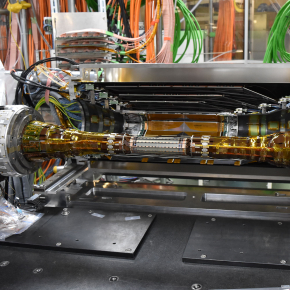Particle physics: Focus on BELLE-II before the experiment restarts
In early 2024, the BELLE-II particle physics experiment at KEK in Japan will restart after a year and a half of technical shutdown. This break has allowed upgrades for both the SuperKEKB accelerator, which produces electron-positron collisions, and the detector. The analysis of the data recorded since 2019 has led to numerous results presented at the 2023 summer conferences, including a first hint of a rare b quark transition, made possible by the unique experimental conditions of BELLE-II.
Major improvements
After a year and a half of technical stop, the Belle II experiment, located in Tsukuba, Japan, is ready to resume data collection. This break has allowed several upgrades for both to be made to the SuperKEKb acceleratorl and the detector itself. In particular, shielding was added to the accelerator to reduce background noise from the beams. The major modification was to install the second layer of the pixel vertex detector (located at the centre of the detector), which will be key to measure for time-dependent CP violation in order to characterise the differences between matter and antimatter. Until December 2023, the detector will be gradually restarted, taking data from cosmic ray particles. The accelerator, however, will restart at the beginning of 2024, producing collisions until July, with the goal of breaking the world record for instantaneous luminosity previously reached at 4.7.1034 /cm2/s.

First analyses of BELLE-II data
During this technical stop, the experiment's physicists analysed the data recorded between 2019 and 2022, corresponding to a statistic of 424 fb-1, around half the data recorded in the previous experiment, Belle. Numerous results were presented at the Summer 2023 conferences, including a first hint of the rare b-quark transition decaying into a strange quark and two neutrinos (b → s ν anti-ν) using the decay of the B+ meson into K+ ν anti-ν. These results, to which the IPHC Strasbourg team made a significant contribution, were presented in a seminar at CERN on 7 November (if we wait until the seminar to publish...).
This decay is predicted with high precision by the Standard Model of particle physics, at a rate of the order of 5.10-6. A very low rate which represents however a challenge from an experimental point of view, as the only visible particle in the final state is a kaon, which is difficult to identify from the multitude of kaons commonly produced by the experiment in the decays of beauty mesons. Belle-II offers unique experimental conditions for the search for such a final state, with a large invisible part, thanks in particular to the excellent knowledge of the total energy and momentum of the lepton collision, making it possible to kinematically constrain the invisible part.
Changes in collaboration
Finally, on the management side, Karim Trabelsi, former researcher at IJClab and current director of the TYL international research laboratory), was elected spokesperson for the Belle-II collaboration last June for a 2-year term. At the IN2P3 level, he has been replaced by CPPM researcher Justine Serrano as scientific manager of the Belle II Master Project.
The BELLE-II experiment
BELLE-II is an experiment studying electron-positron collisions delivered by the SuperKEKB collider, located at KEK in Japan, near Tokyo since 2019. Its aim is to detect signs of new physics, not described by the Standard Model of particle physics, using very high-precision measurements. For example, it is looking for the existence of hypothetical dark matter particles or lepto-quarks, which could explain the recent anomalies observed in B mesons decays. Three IN2P3 laboratories - the Marseille Particle Physics Centre, the Hubert Curien pluridisciplinary Institute in Strasbourg, the(Laboratory of the Physics of the two Infinities Irène Joliot-Curie in Orsay and the IN2P3 Computing Centre in Lyon - are currently involved in the experiment.
